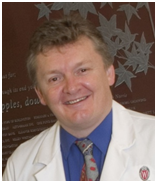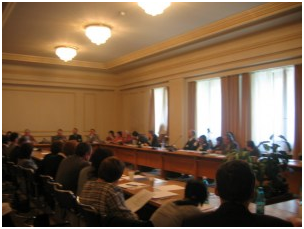Making Global Access to Pain Relief Personal!
by IAHPC Board member James F. Cleary, MD, FRCAP, FAChPM, -- from his blog*

April 8, 2011: It is 4:30 am here in Hong Kong. I am awake. Jet Lag.
I am attending the 3rd Asian Oncology Summit hosted by Lancet Oncology and Elsevier.
….Up to 70 million people/year may be experiencing untreated severe pain at the end of life in Asia alone….Cancer is and will continue to be a growing problem in Asia along with the other non communicable diseases.… Dr Judith Mackay, a Hong Kong physician,… reminded me that last year during a question time, I had asked, “How many of you, if diagnosed with an advanced cancer, would want access to opioids for the treatment of cancer pain?” I raised my hand from the podium to show I was looking for a response. 3000 hands were raised! Okay I didn’t count, but I could see a sea of hands across the cavernous hall.
Judith’s hand was raised; she told me today that it was during August when cancer pain relief got personal. If she is faced with an advanced cancer diagnosis, she wants access to opioids for pain relief…. Livestrong has found during interviews in numerous countries that people are consistently concerned about two things: the stigma associated with cancer and fear of cancer pain. Doug Ulman, CEO of Livestrong, had his hand up, as did John Seffrin and Otis Brawley of the American Cancer Society and David Hill and Carey Adams of the UICC to name just few.
I first asked this question while working with Dr Daniela Mosiou and her colleagues in Romania to address the barriers to opioid availability in their country. As part of bringing about major changes in their laws…, we were asked to address a meeting of 100 stakeholders at the Romanian Parliament…. With only 5 minutes before the scheduled coffee break, I was asked to delay my talk. I indicated to the chair that I would rather not…I only needed 5 minutes.
… I said, “I will shorten my comments and simply ask a question.” “How many of you, if diagnosed with an advanced cancer, would want access to opioids for the treatment of cancer pain?” …All hands went up progressively around the circle until even the drug police to my immediate right had their hands raised. I then ask, “Why are we denying the people of Romania access to opioids for pain relief?” ….

Romanians are no longer denied access to opioids for pain relief. That is not to say that everyone who needs them gets them. This is a long process,…morphine is a 200 year old drug, the use of which still seems novel, despite the 1961 UN Single Convention on Narcotic drugs…. “The medical use of narcotic drugs continues to be indispensable for the relief of pain and suffering…adequate provision must be made to ensure the availability of narcotic drugs for such purposes.” (Preamble, page 13).
The Pain and Policy Studies Group (PPSG) has been about ensuring the availability of narcotic drugs for the relief of pain and suffering. We do not make decisions on what is an appropriate medical purpose….Dave Joranson took this “concept of balance” from PPSG to the WHO and the second edition has just been released by the WHO, under the leadership of Willem Scholten, and endorsed by the International Narcotic Control Board: http://www.who.int/medicines/areas/quality_safety/guide_nocp_sanend/en/index.html
We must prevent abuse and diversion while ensuring availability for medical purposes. We need to use evidenced based means to assess, report and prevent abuse and diversion of opioids and make decisions as to what are the appropriate medical purposes. Should opioid use only be limited to those with advanced cancer? What about those immediately post surgery, those who are have chronic arthritis, and those with pain from HIV and other life limiting situations? What about my mother, who as a hospice nurse brought the concept of oral morphine use back to South Australia from St Christopher’s, but now has significant and debilitating pain from spinal stenosis?
Yes, Judith, this is personal for me, too. Like you, I want ready access to opioids if I am faced with an advanced cancer diagnosis. I want this for me, my wife and my children and I want it for my mother, even though she doesn’t have cancer.
And I am sure it is personal for the millions of people around the world who are suffering from pain and have no access to pain relief.
*Dr. Cleary is an Associate Professor of Medicine (Division of Heme/Onc) at the University of Wisconsin School of Medicine and Public Health; Director of the Palliative Care Program at the University of Wisconsin Hospital and Clinics; Program Leader of the UW Carbone Cancer Center’s Cancer Control Program; Director, Pain & Policy Studies Group; Director, WHO Collaborating Center for Pain Policy and Palliative Care. He is also a member of the Board of IAHPC. For his complete biography please see: http://www.painpolicy.wisc.edu/PDFs/Bio/ClearyBio.pdf
The entire unedited story related in Dr. Cleary’s Blog may be found at http://painpolicy.wordpress.com/ The above piece was previously published in the aforementioned site and a condensed and edited version is reprinted here with permission.
New WHO publication available to help improve access to treatment
Ensuring Balance in National Policies on Controlled Substances
Guidance for Availability and Accessibility for Controlled Medicines
This book from the World Health Organization provides guidance on policies and legislation with regards to availability, accessibility, affordability and control of medicines made from substances regulated under the international drug control conventions, herein referred to as “controlled medicines”….
This book elaborates on the background and then provides 21 guidelines on various topics: content of drug control legislation and policy; authorities and their role in the system; policy planning for availability and accessibility; healthcare professionals; estimates and statistics; procurement; and nationally listed drugs. Each guideline has an elucidation and a description of the legal context. The Country Assessment Checklist enables the user to determine which guidelines still need to be worked on. A CD-ROM provides additional information.
Target audience: policy-makers, regulators (in government, administrative departments, national competent authorities) and politicians; academia and civil society; healthcare professionals and their organizations; individuals (including patients and their families) and organizations whose area of work or interest is drug control or public health.
Book and reference list freely downloadable online in 14 languages at
http://www.who.int/medicines/areas/quality_safety/guide_nocp_sanend/en/index.html and the Repository of the WHO Library: (http://dosei.who.int/uhtbin/webcat )
Available in hardcopy in English and French:
[E]: 78 pages, ISBN 978 92 4 156417 5, Order no. 11500807
[F]: 78 pages, ISBN 978 92 4 256417 4, Order no. 21500807
Price. CHF/US$ 25.00, In developing countries: CHF/US$ 17.50
Email: [email protected] - Web site: http://www.who.int/bookorders
| 
